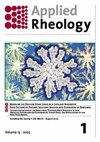Synthesis and characterization of a new complex based on antibiotic: Zirconium complex
IF 1.8
4区 工程技术
Q1 MECHANICS
引用次数: 0
Abstract
Abstract It is well known that sulfonamide derivatives, through exchange of different functional groups without modification of the –S(O)2N(H)– function, can exhibit a wide variety of pharmacological activities. In addition, some metal complexes of these ligands have been prepared to promote rapid healing of burns in humans and animals, for example, the complex of Zn(ii) sulfadiazine. Their effectiveness does not depend solely on the slow release of the metal ion, but rather strongly on the nature of the material to which the metal is bound. Given the ability of sulfonamide derivatives to coordinate with metal atoms in different ways, considerable interest in the synthesis and structural aspects of new complexes has arisen. These results confirm that the significant chemical capacity of sulfonamides to act as ligands is based on the acidity of its –S(O)2N(H)– function, which gives a donor anionic ligand, allied to the presence of atoms vicinal to nitrogen, sulfur or oxygen of the heterocyclic ring, which provide the stereochemical requirements for the realization of complexes with monodentate ligand, chelating agent or bridging ligand, providing monomeric structures, dimeric arrangements and polymers. In addition, the aromatic amino group is responsible for the chemical versatility of the sulfonamides, since it can act as a coordination site, as well as a reactive site for chemical modifications of sulfonamide complexes with very interesting biological purposes. In the present work, the synthesis and structure of a novel sulfanilamide complex: nitro (4-aminobenzenesulfonamide) zirconium was presented. Characterization of the complex was performed by infrared spectroscopic, thermogravimetric and X-ray diffraction analysis.一种新型抗生素配合物锆配合物的合成与表征
摘要众所周知,磺酰胺衍生物通过不同官能团的交换而不修饰-S(O)2N(H)-功能,可以表现出多种药理活性。此外,已经制备了这些配体的一些金属配合物,以促进人和动物烧伤的快速愈合,例如,锌(ii)磺胺嘧啶的配合物。它们的有效性不仅取决于金属离子的缓慢释放,而且在很大程度上取决于与金属结合的材料的性质。鉴于磺酰胺衍生物以不同方式与金属原子配位的能力,人们对新配合物的合成和结构方面产生了相当大的兴趣。这些结果证实,磺酰胺作为配体的显著化学能力是基于其-S(O)2N(H)-官能团的酸性,该官能团提供了供体阴离子配体,与杂环中氮、硫或氧附近原子的存在相结合,这为实现与单齿配体的配合物提供了立体化学要求,螯合剂或桥接配体,提供单体结构、二聚体排列和聚合物。此外,芳香氨基对磺酰胺的化学多功能性负责,因为它可以作为配位位点,也可以作为磺酰胺配合物的化学修饰的反应位点,具有非常有趣的生物学目的。本文介绍了一种新的磺胺配合物:硝基(4-氨基苯磺酰胺)锆的合成和结构。通过红外光谱、热重分析和X射线衍射分析对配合物进行了表征。
本文章由计算机程序翻译,如有差异,请以英文原文为准。
求助全文
约1分钟内获得全文
求助全文
来源期刊

Applied Rheology
物理-力学
CiteScore
3.00
自引率
5.60%
发文量
7
审稿时长
>12 weeks
期刊介绍:
Applied Rheology is a peer-reviewed, open access, electronic journal devoted to the publication in the field of applied rheology. The journal provides the readers with free, instant, and permanent access to all content worldwide; and the authors with extensive promotion of published articles, long-time preservation, language-correction services, no space constraints and immediate publication.
 求助内容:
求助内容: 应助结果提醒方式:
应助结果提醒方式:


